As Middle Tennessee State University continues navigating its spring semester with a mix of course deliveries, significant technology upgrades during the past year because of the pandemic has placed the Blue Raider campus on the cutting edge locally, regionally and nationally in providing a deeper higher education experience for students.
Like many other academic institutions across the country, MTSU purchased a comprehensive Zoom license in March 2020 to begin the unexpected and rapid transition to all-remote instruction to stop the spread of COVID-19. But infrastructure was needed to equip hundreds of classrooms with video lecture and recording capabilities in addition to the faculty training needed to make the switch a successful one.
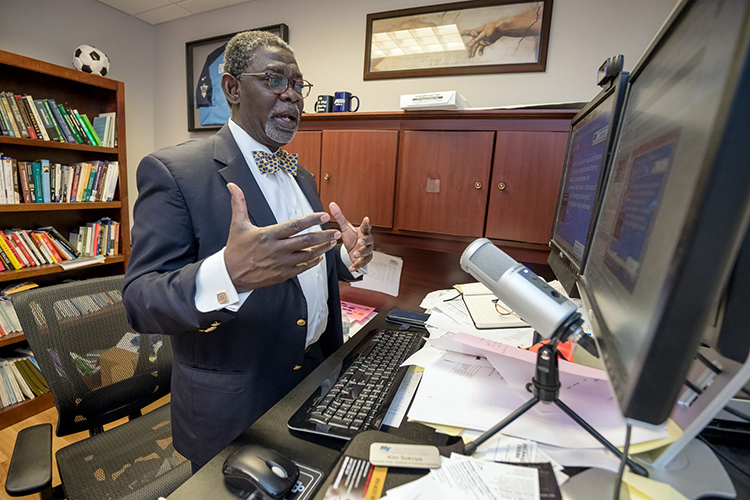
Dr. Kim Sokoya, associate dean for Graduate and Executive Education, records his lecture in mid-March 2020 for an online class for the College of Business. (MTSU photo by J. Intintoli)
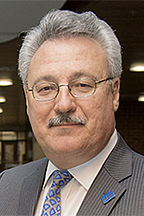
Bruce Petryshak

Dr. Albert Whittenberg
At the forefront of this pivot was the university’s Information Technology Division in partnership with administration, faculty and other technology leaders across campus as the institution embarked on a multimillion-dollar investment to provide faculty, staff and students with the ability to carry on its academic mission in an environment like few had experienced before.
The result? Albert Whittenberg, ITD’s assistant vice president for academic and instructional technologies, said the campus now has more than 400 “smart classrooms” that are equipped with a projector, document camera and other technology that allows an instructor to enter the classroom, push a button or two, and effectively teach a class both in-person and virtually.
“We wanted to make it so that the faculty didn’t have to learn a bunch of new technology. They could simply go in and the room would be set up to automatically start recording when the lecture began, giving them a cue,” Whittenberg said. “I have to give a lot of kudos to our faculty because they knocked it out of the park. Introducing a new technology is always a risk, but they just jumped on it and excelled with it … and really tried to make it better and better.”
Bruce Petryshak, vice president for informational technology and chief information officer, said the roughly $3.5 million investment into upgrading classroom technology was always done with an eye toward the future.
“We tried to look at the investment through a long-term lens, thinking that it’s less effective if they’re only valid for the pandemic, “ Petryshak said. “That was done with the intent of an improved learning process, period. … I think it has value to the whole educational experience beyond COVID.”
Faculty embrace new technology
In addition to Zoom and “D2L,” the acronym for the university’s Desire2Learn online learning management system for students and faculty, the Panopto video management system has been heavily integrated into the instructional toolkit, thus giving professors and lecturers the ability to create video presentations, capture and record lectures, add narrations to presentations and other tools enabling the university to offer a wide variety of hybrid courses.
In addition to the speed in which it occurred, MTSU’s venture into virtual delivery was impressive in scale — transitioning roughly 5,000 on-campus, in-person courses to remote teaching and learning in just a few weeks. Whittenberg noted that Harvard University, for example, had only brought 50 such “smart classrooms” on line in response to the pandemic; and Panopto had to provide MTSU with customized services to handle the extraordinary volume of virtual class content that needs to be constantly uploaded and stored.
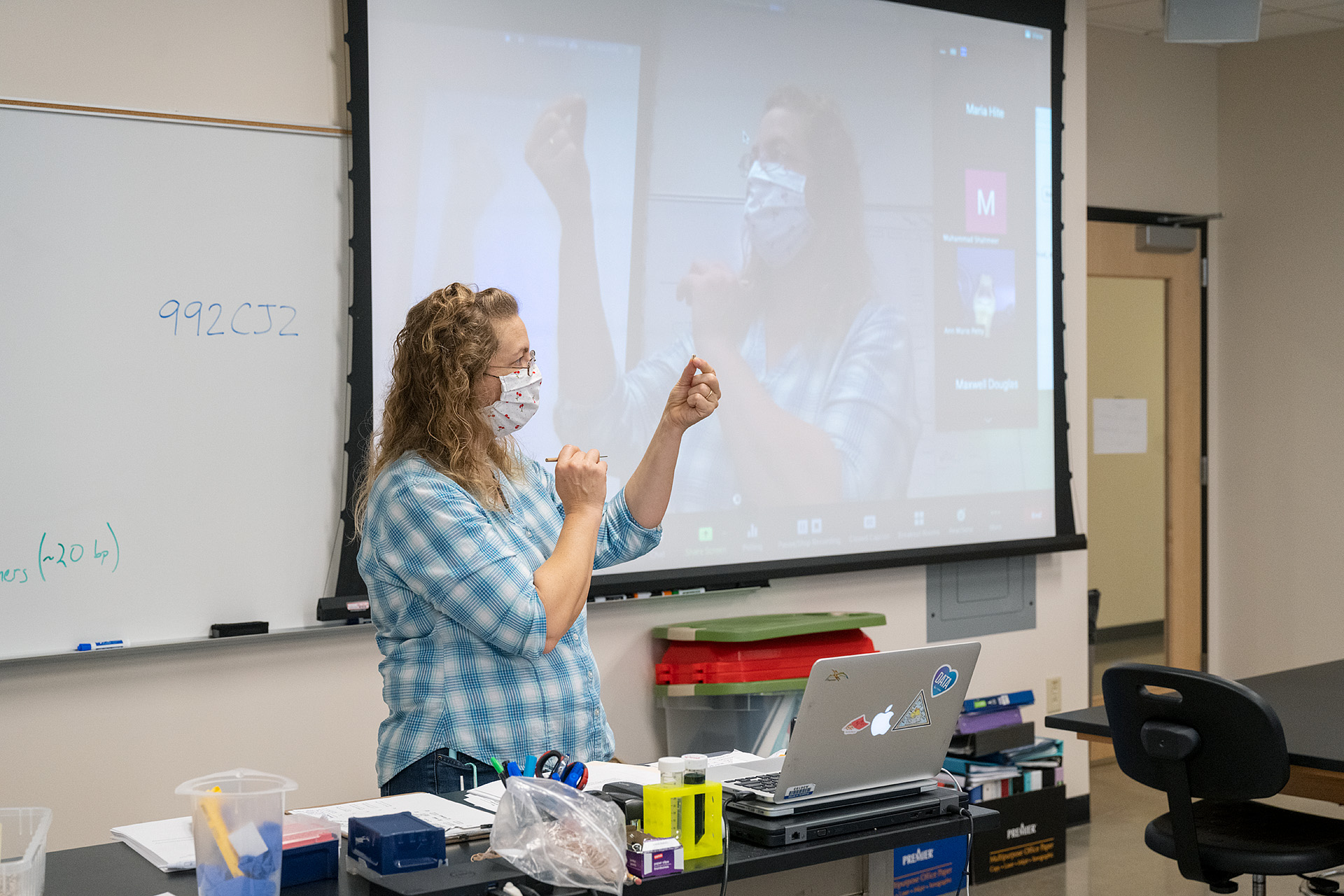
In this Fall 2020 file photo, Rebecca Seipelt-Thiemann teaches her Honors Genetics class in the Science Building. MTSU’s Information Technology Division upgraded dozens of classrooms across campus with video recording and other virtual technology to allow instructors to teach courses remotely amid the ongoing coronavirus pandemic. (MTSU photo)
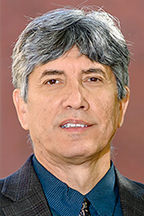
Carlos Coronel

Dr. Susan Myers-Shirk
ITD also tapped the expertise of Carlos Coronel, director of the Jones College of Business IT Resources who already had extensive experience with Panopto and virtual course delivery, as well as faculty and staff in the Learning, Teaching and Innovative Technologies Center.
To facilitate faculty buy-in, Whittenberg said he and Susan Myers-Shirk, history professor and MTSU director of general education, also held a series of Zoom sessions with groups of faculty across the campus to get their feedback about moving to an all-remote learning environment by mid-March 2020. That online posture continued through the summer, transitioning to a hybrid environment last fall as coronavirus spread somewhat lessened and modified in-person classes resumed across campus.
Petryshak said faculty embraced the pivot to all remote instruction and enthusiastically participated in the virtual training sessions, with all faculty members attending at least one training session and many multiple.
“And they helped each other, which was a really big thing. The ones who were really good at it helped the ones that were struggling a bit,” he said.

Dr. Rick Cottle
Rick Cottle, associate professor of fashion merchandising and Faculty Senate president, echoed Petryshak’s perspective.
“The vast majority of faculty embraced the technology,” Cottle said, adding that he was also “pleasantly surprised” in Faculty Senate discussions to see some long-time faculty who he thought would have been resistant to remote instruction seeking ways to actually improve their remote teaching abilities through even more tech upgrades.
Cottle also had to personally adjust, having never taught via Zoom before the university’s pivot to all-remote instruction last spring and whose online learning experience was limited to his own pursuit of an all-online MBA back in the early 2000s, when online education technology was quite limited.
Now all of a sudden, as a faculty member, he was faced with learning the meaning of new terminology such as “remote synchronous” and “remote asynchronous” courses and growing comfortable with the unfamiliar and somewhat unsettling feeling of seeing recordings of himself teaching on camera and hearing just how much twang resides in his familiar Southern accent.
“I panicked actually,” Cottle said of MTSU’s move to an all-remote environment. “I had three in-seat classes and a couple of studio classes where students come in for three hours developing products and business plans … and all of a sudden we can’t meet anymore.”
The transition required patience as he and his students adjusted to the virtual environment, with some students struggling at first — “so faculty had to be flexible” — and him becoming more comfortable teaching virtually.
“It’s made me a better teacher. It’s helped me go back and look at some of the things I’m doing in class, in-person. Having it recorded will help me build a better classroom experience by reviewing what I do and it also gives the students more flexibility as well in case they need to miss a class.”
Flexibility for diverse student population
But shifting online also meant that students needed to be properly equipped to access these online assets. For a university that prides itself on providing higher ed mobility to many first generation college students, technology access isn’t always a given, especially during an economically devastating pandemic.
Led by Petryshak, ITD also has accumulated an inventory of laptops and hotspots that could be loaned out to students needing technology assistance. The service has proven to be quite popular.
Last spring, ITD worked with T-Mobile to secure 1,000 Chromebooks to loan to student in addition to 300 laptops that came from MTSU’s existing inventory. The division also distributed 2,100 internet hotspots, 200 webcams and 50 headsets. In early fall, almost 430 Chromebooks, 40 MacBook Airs, 130 PCs and 600 hotspots had been requested.
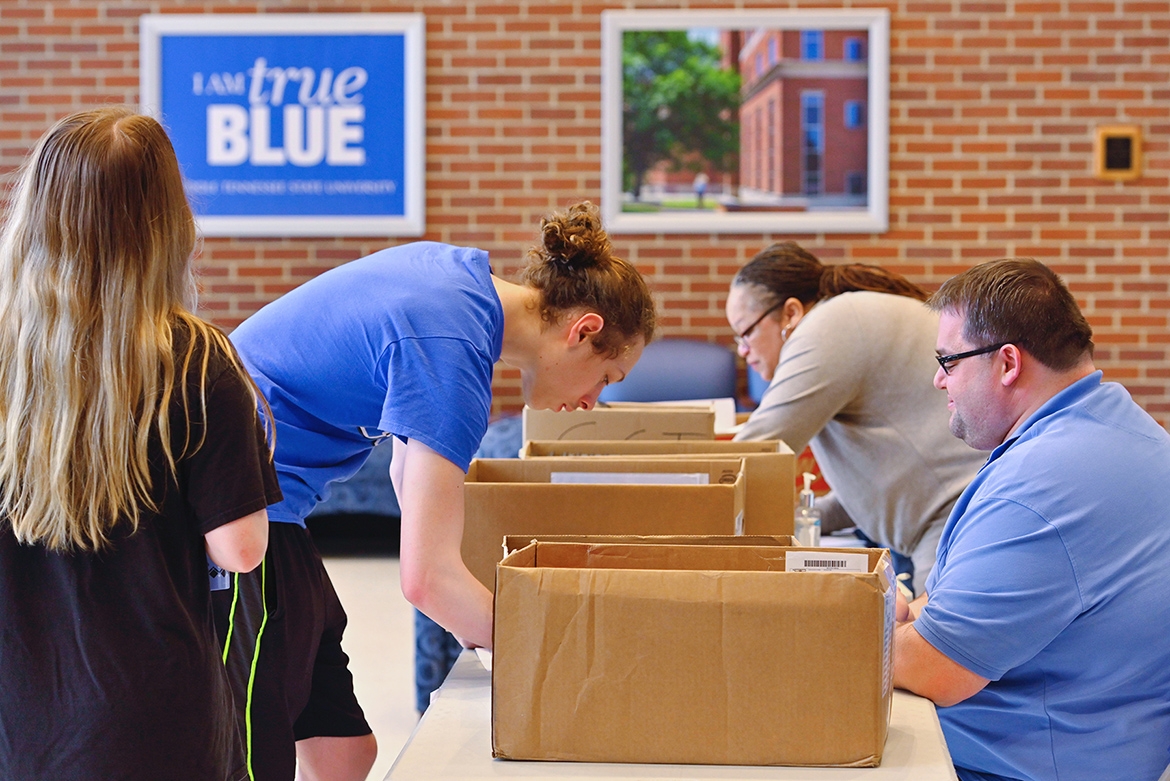
In this file photo, staff with MTSU’s Information Technology Division helps students with laptop and internet hotspot checkouts in the Cope Administration Building lobby in Spring 2020. ITD has been lending a limited supply of such technology to students who need it since the university moved to remote courses for the rest of the spring semester. (MTSU file photo by Cat Curtis Murphy)
Faculty also benefited, as one of the bulk equipment purchases was the option of a personalized laptop for all instructors that they could bring into and carry out of the classroom so that their ability to effectively teach a course wasn’t dependent on the status of the desktop computer already set up in the classroom and used by multiple instructors.
The instructor simply plugs in the laptop and a high quality recording of their lecture begins, including capture white board notes, content on the document camera and other supplemental materials that the faculty member wants to share.
“It lends itself nicely to help us pivot on the pandemic because we can do remote teaching, but the value of it, No. 1, is that it’s all automatic,” Petryshak said.
Spring semester has continued the progress, with on-campus coronavirus cases remaining manageable and President Sidney A. McPhee recently announcing plans for “the return of normal (and pre-pandemic) operations on campus” for Fall 2021.

Dr. Sidney A. McPhee
“We have a diverse student population on our campus that mirrors the broader society. Many of our students hold part-time or full-time jobs, are raising young families or caring for older parents,” McPhee said. “They require flexible and creative learning environments to balance life and learning. … By finding ways to make higher education more accessible and responsive to student lifestyles, we are helping shape the future of education.”
Rick Sluder, vice provost for student success and dean of University College, said ITD’s assistance over the past year was critical in helping the university’s online course offerings and delivery attractive to prospective students looking for that flexibility.
“MTSU has a history of exceptionally strong leadership in ITD operations. And, the university has been engaged in online course delivery for more than 20 years, which was a primary strategic emphasis area long before the pandemic,” Sluder said.

Dr. Rick Sluder
“Nationally, institutions with pre-existing strengths in both areas seemed more flexible, adaptable and prepared to support the needs of both students and faculty. These factors were largely responsible for enabling MTSU to achieve the highest retention rates in the history of the institution, something that doesn’t happen by accident.”
‘Setting up our classrooms for the future’
So coming semesters will likely be a new normal of sorts, as the benefits of classroom technology provide students with greater flexibility in absorbing course content. Because of the integration of video lectures within the D2L platform, students don’t have to search for such recorded lectures and can easily access them with a few clicks within D2L based on their class schedules.
“This is kind of setting our classrooms up for the future, because even if we go back to all of our students being here, these lectures are being recorded, therefore students would have the capability of going back and watching them as many times as they want,” Whittenberg said.
“If there’s a particular topic a student is not understanding, and it’s one o’clock in the morning and they can’t call their professor, they can go back and look at that one clip over and over again until they hopefully figure it out or at least know what they need to ask the professor to better understand.”
Petryshak said ITD is developing a prototype classroom for the future that includes a series of frameless monitors that somewhat envelops the physical classroom, equipped with highly sensitive microphones that would allow students within the class to interact with virtual students in real time and vice versa.
“The interaction really becomes pretty dynamic,” he said.
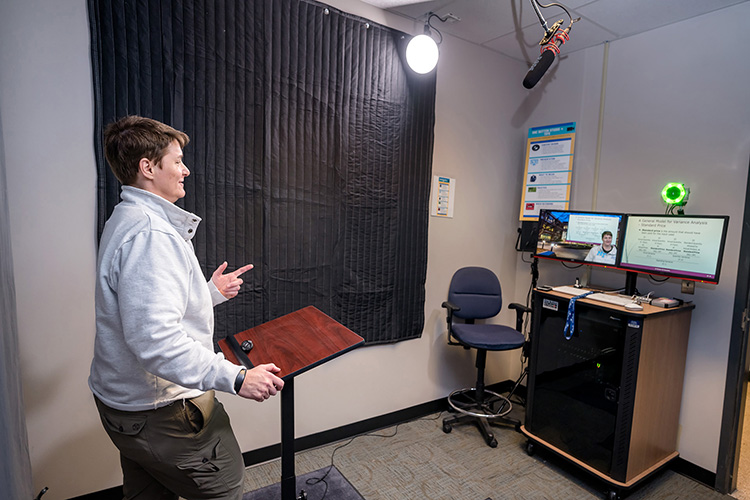
Finance professor Anne Anderson, Weatherford Chair of Finance, tapes a lecture for an online class in the Jones College of Business One Button Studio. (MTSU photo by J. Intintoli)
On Cottle’s wish list is all classrooms being equipped with motion-controlled cameras that follows the instructor around the classroom. He agrees that the technological enhancements will continue.
“One thing that’s coming is instructional design technologists. I could envision every single department having one,” he said, thus pairing a technology expert with the faculty content expert. “Let’s figure out as a team how we best deliver this.”
As chair of the university’s Technology Access Fee Committee, which oversees technology upgrades to classrooms financed by the student fee, Cottle sees a time when virtual and augmented reality technology as well as more 3D printing capabilities will be incorporated into course instruction.
He noted that the university’s new physician assistant program is incorporating “wonderful virtual technology” to be able teach students online.
“The students are the ones who are going to change industry,” Cottle said. “It’s all coming from the technology. … I think it can get better.”
For more information about MTSU’s Information Technology Division, visit https://www.mtsu.edu/itd/index.php. You can find a series of faculty profiles titled “Service to Students During the Pandemic” at https://mtsunews.com/service-to-students/.
— Jimmy Hart (Jimmy.Hart@mtsu.edu)

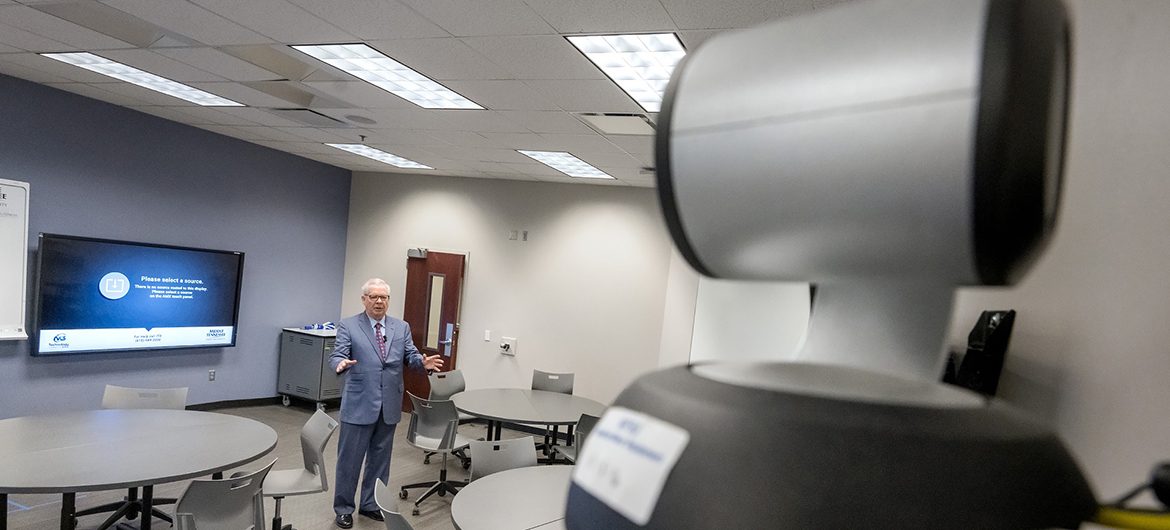
COMMENTS ARE OFF THIS POST